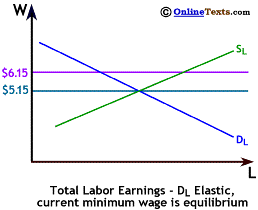

In late August it seemed a near certainty that the U.S. Federal Minimum Wage would be increased in two US50¢ increments, from its current level of US$5.15 to US$6.15, over a two year period. Such an increase could still pass before the current session of congress adjourns. Increasing the U.S. Federal Minimum Wage is a popular idea because it seems to help those with low incomes, allowing increased rewards for working rather than through transfers such as welfare and medicare; additionally, it seems to place the cost on business rather than directly on taxpayers. When analyzing policies such as this, economists must: evaluate whether policies achieve their stated goals; evaluate the direct and indirect costs of these policies and who bears these costs; look at whether the policy enactment leads to unintended consequences; and sometimes recommend alternative policies to achieve the stated goals. We won't cover all this ground here, but we consider some of the consequences, intended and otherwise, of an increase in the U.S. minimum wage.
Suppose, for example, we know that raising the U.S. Federal Minimum Wage will improve living standards for those who earn minimum wage in the U.S.; a logical concern might be, will it cost some people their jobs? If so, will raising the U.S. Federal Minimum Wage cause widespread layoffs, or lead to only modest job loss? In addition to layoffs, the higher wages may bring new people into the labor force hoping to find higher paying jobs; if so, will this lead to even greater unemployment? Will increased production costs result in reduced profits for businesses, or will the increased costs be passed along to consumers in the form of higher prices, or perhaps both?
The U.S. Federal Minimum Wage is an example of a price floor. A price floor specifies the minimum legal price for a good or service. If the price floor is below the equilibrium price, then the floor has no direct impact on prices. If the price floor is above the current equilibrium price, the effect is to create an excess supply (or surplus) of the good with the regulated price. Surpluses are an unintended consequence of imposing or increasing a price floor; therefore, an unintended consequence of an increase in the U.S. Federal Minimum Wage might be an increase in unemployment. The unemployment rate is the percentage of people actively seeking employment who are unable to find jobs. Those who are not actively seeking work are not considered unemployed. One way in which an increase in the U.S. Federal Minimum Wage can generate unemployment is that it can draw people into the labor force who had chosen not to seek employment at the lower wage; the other way, and the one most people are more concerned about, is that it can induce firms to layoff current workers as product prices rise and product demand falls, or as it becomes more practical to replace some workers with capital equipment. If we increase the U.S. Federal Minimum Wage, will unemployment increase? And if so, how much of that increase is due to layoffs, and how much due to new job seekers? It turns out that part of the answer to these questions lies in the elasticity of labor demand and supply.
A Brief Review of Labor Demand and Supply Elasticity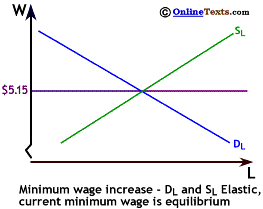
To the right we examine an increase in the U.S. Federal Minimum Wage when both labor demand, DL, and labor supply, SL, are very elastic (the break in the vertical axis indicates a portion left out so that we can focus on the region from US$5.15 to US$6.15). When labor demand and supply are both elastic, an increase in the U.S. Federal Minimum Wage can lead to large increases in unemployment. In the market depicted to the right, the current U.S. Federal Minimum Wage of US$5.15 is also the U.S. Equilibrium Wage (this is unlikely, but the basic results are the same and this is graphically much simpler). At the current wage of US$5.15, N* workers are both supplied and demanded so there is no unemployment and no labor shortage. When the U.S. Federal Minimum Wage increases to US$6.15, only ND workers are demanded, and since quantity demand is less than quantity supplied, only ND workers will be employed. The increase in the U.S. Federal Minimum Wage when labor demand is elastic means that N* - ND workers lose their jobs, labeled Lost Jobs. The increase in the U.S. Federal Minimum Wage brings the total number of available workers to NS. Of that total, N* - NS new workers have entered the labor force looking for work at the new higher wage rate, labeled New Seekers, but the result is to further increase the number of unemployed workers. Overall, the increase in the U.S. Federal Minimum Wage in this market has led to an increase in the number of unemployed workers from zero to NS - ND, labeled Unemployment. Thus, if the new U.S. Federal Minimum Wage is above the equilibrium and labor demand is elastic, many current workers will lose their jobs; and if labor supply is elastic, many people will enter the labor force in hopes of finding nonexistent higher wage jobs.
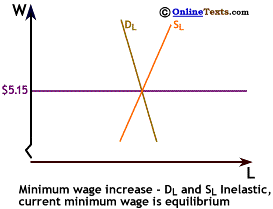
If labor demand and supply are inelastic, the effect of an increase in the U.S. Federal Minimum Wage is qualitatively the same as if either labor demand or supply were elastic, in that it leads to unemployment; however, it is quantitatively very different, in that the added unemployment is far smaller. To the right we show the effects of an increase in the U.S. Federal Minimum Wage when both labor demand, DL, and labor supply, SL, are very inelastic. Once again, we consider the case in which the current U.S. Federal Minimum Wage of US$5.15 is also the U.S. Equilibrium Wage. When the legal U.S. Federal Minimum Wage increases to US$6.15, the quantity of labor demanded falls to ND, and the quantity of labor supplied increases to NS. These quantity changes are far smaller than they would be if either labor demand or supply were elastic. Increased unemployment is still a consequence of the increased U.S. Federal Minimum Wage, but the amount of unemployment is much smaller. The number of workers who lose jobs that they had prior to the wage increase is given by N* - ND, labeled Lost Jobs. The number of lost jobs is a small fraction of what it would be if labor demand were elastic. The number of new workers entering the labor market is also much smaller, NS - N*, labeled New Seekers. The sum of these two types of unemployment gives us the total addition to unemployment created by the increase in the U.S. Federal Minimum Wage, NS - ND, labeled Unemployment on the graph.
We do not offer a new graphical analysis here, but we learned (or will learn) in the section on Factor Markets that, in the case of Monopsony, an increase in the Minimum Wage can lead to an increase in employment. To the extent that Monopsony describes the hiring situation for firms affected by the minimum wage, the unemployment consequences of raising the minimum wage may be somewhat offset. Nevertheless, it seems likely that monopsony is not a good description of labor hiring in more populous parts of the U.S. but it may well describe the situation in smaller towns in less densely populated areas.
We can now answer some of the questions that we posed at the beginning of this article. If the U.S. Federal Minimum Wage is increased and if the new U.S. Federal Minimum Wage is above the U.S. Equilibrium Wage, it will lead to some unemployment. Some of that unemployment will be due to lost jobs, while some will be due to new entrants into the labor market. The number of lost jobs in the U.S. will be smaller if labor demand is inelastic and if monopsony describes many of the affected industries, and the number of new U.S. job seekers will be smaller if labor supply is inelastic. We still can't say what trade-offs society should be willing to accept, but we can say that, all else being equal, the more inelastic the demand and supply for labor, the smaller the impact on unemployment.
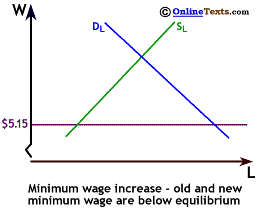
Suppose, the U.S. Equilibrium Wage is above the new U.S. Federal Minimum Wage. To the right, we show the effect of an increase in the U.S. Federal Minimum Wage from US$5.15 to US$6.15 when the current U.S. Equilibrium Wage is US$6.35. In the market depicted to the right, the U.S. Equilibrium Wage is US$6.35 and the number of workers employed is N*. In this market, an increase in the U.S. Federal Minimum Wage has no immediate impact on wages paid or on the number of workers hired.
Even if the U.S. Federal Minimum Wage is below the U.S. Equilibrium Wage, increasing it may have a long-run effect. A worker earning US$6.35 was earning US$1.20 above the U.S. legal minimum wage before the increase. After the increase, she is earning only US20¢ above the U.S. Federal Minimum Wage. If workers care not just about their hourly wage but about their wage in relationship to the legal minimum, it will affect their labor supply. If enough workers feel this way, the labor supply curve will shift back whenever the U.S. Federal Minimum Wage increases causing the U.S. Equilibrium Wage to increase, even though it was already above the U.S. Federal Minimum Wage. (We leave it to the reader to graph these effects.)
Perhaps another way to evaluate the effect of increasing the U.S. Federal Minimum Wage is to ask what happens to total earnings of all workers earning the minimum wage. Should society be more willing to accept the unemployment results from increasing the minimum wage if the total earnings (hours worked multiplied by the U.S. Federal Minimum Wage) rose, but not if it fell? We can't answer that, but we can say under what conditions total earnings will increase and under what conditions it will decrease. It should come as no surprise that the answer lies in the elasticity of the demand for labor.

Consider the market shown to the right. This is similar to the first market we considered when labor demand is elastic. (In this case we do not show a break in the vertical axis because we are illustrating total earnings by a rectangular area so the graph must be to scale.) Here we interpret the horizontal axis not as the number of workers but as the number of hours worked at the U.S. Federal Minimum Wage. When the U.S. Federal Minimum Wage is US$5.15, the number of hours worked is N5.15. The green rectangle is the product of these two (US$5.15 X N5.15) and represents the total amount earned by U.S. Federal Minimum Wage earners at the old U.S. Federal Minimum Wage. When the U.S. Federal Minimum Wage increases to US$6.15 the total number of hours falls to N6.15. Labor demand is very elastic in this case so the number of hours under the higher U.S. Federal Minimum Wage falls by a greater percentage than the U.S. Federal Minimum Wage rose. As a result, the total earnings at the higher U.S. Federal Minimum Wage (US$6.15 X N6.15) are smaller than under the old U.S. Federal Minimum Wage.
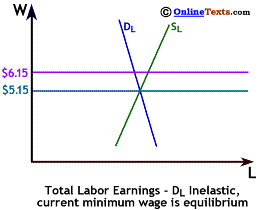
When labor demand is inelastic the reduction in hiring is smaller in percentage terms than the increase in the U.S. Federal Minimum Wage. In this case, total earnings under the old U.S. Federal Minimum Wage (US$5.15 X N5.15), shown by the green rectangle, are smaller than total earnings under the new U.S. Federal Minimum Wage (US$6.15 X N6.15), shown as the pink rectangle.
In general, increasing the U.S. Federal Minimum Wage will create unintended (though perhaps not unexpected) unemployment; however, the more inelastic labor demand is the fewer layoffs, and the more inelastic labor supply is the fewer disappointed new entrants into the labor market. If labor demand is inelastic, total earnings for U.S. Federal Minimum Wage earners will rise; while total earnings will fall if labor demand is elastic.
It seems fair to say that given our analysis, increasing the U.S. Federal Minimum Wage creates smaller unintended consequences when labor demand, in particular, is inelastic. With unemployment rates at a 30-year low in the U.S., the effect of an increase in the U.S. Federal Minimum Wage on unemployment will probably be small. In many localities throughout the U.S., the Equilibrium Wage is already above the proposed US$6.15 Federal Minimum Wage so the impact will be even smaller where that is true, though, as we noted, it could still have a long-run effect through a change in labor supply.
An increased U.S. Federal Minimum Wage will increase costs to U.S. businesses who employ U.S. Federal Minimum Wage workers. To the extent that these firms sell products whose demand is inelastic, they will be able to pass some of this added cost on to consumers in higher prices. Where U.S. businesses sell products whose demand is elastic, more of the cost will be absorbed by the firms in the form of reduced profits.
The impact of this increase in the U.S. Federal Minimum Wage will probably be fairly small in most regards, though the effects will vary from locality to locality depending on local wages, unemployment and labor demand in the U.S. The greatest danger in terms of unintended consequences may come if the U.S. economy were to slide into a recession. Politically, it is much easier to increase the U.S. Federal Minimum Wage than to decrease it. If, due to a recession, the U.S. Equilibrium Wage falls well below the U.S. Federal Minimum Wage, and if labor demand becomes more elastic, the unintended consequences of a higher U.S. Federal Minimum Wage could become more serious.
Copyright © 1995-2003 OnLineTexts.com, Inc. - All Rights Reserved